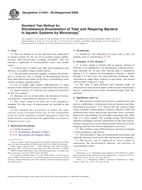Potřebujeme váš souhlas k využití jednotlivých dat, aby se vám mimo jiné mohly ukazovat informace týkající se vašich zájmů. Souhlas udělíte kliknutím na tlačítko „OK“.
ASTM D4454-85(2009)
Standard Test Method for Simultaneous Enumeration of Total and Respiring Bacteria in Aquatic Systems by Microscopy (Withdrawn 2015)
Automaticky přeložený název:
Standardní zkušební metoda pro současné počítání celkového a Respiring bakterie ve vodních systémech mikroskopicky
NORMA vydána dne 1.5.2009
Informace o normě:
Označení normy: ASTM D4454-85(2009)
Poznámka: NEPLATNÁ
Datum vydání normy: 1.5.2009
Kód zboží: NS-27300
Počet stran: 3
Přibližná hmotnost: 9 g (0.02 liber)
Země: Americká technická norma
Kategorie: Technické normy ASTM
Anotace textu normy ASTM D4454-85(2009) :
Keywords:
Water-formed deposits, Bacteria/bacterial control--water, Epifluorescence microscopy, Fluorescence--water analysis, Microscopic examination--water, Pathogens--water, ICS Number Code 07.100.20 (Microbiology of water)
Doplňující informace
| Significance and Use | ||||
|
Measurement of bacterial densities is generally the first step in establishing a relationship between bacteria and other biochemical processes. It is known that the classical plate count procedure underestimates bacterial densities while the epifluorescence direct microscopic procedure more accurately depicts the total numbers of nonviable or dormant and viable cells in a water sample. The acridine-orange INT-formazan reduction technique provides information on the total concentrations of bacteria as well as that proportion which are actively respiring and thus involved in degradative processes. The acridine-orange INT-formazan reduction technique is both quantitative and precise. This procedure is ideal for enumerating both pelagic and epibenthic bacteria in all fresh water and marine environments. The process can be employed in survey studies to characterize the bacteriological densities and activities of environmental waters. |
||||
| 1. Scope | ||||
|
1.1 This test method covers the detection and enumeration of aquatic bacteria by the use of an acridine-orange epifluorescence direct-microscopic counting procedure. This test method is applicable to environmental waters and potable waters. 1.2 Certain types of debris and other microorganisms may fluoresce in acridine-orange stained smears. 1.3 The procedure described requires a trained microbiologist or technician who is capable of distinguishing bacteria from other fluorescing bodies on the basis of morphology when viewed at higher magnifications. 1.4 Use of bright light permits differentiation of single bacteria where reduced formazan is deposited at the polar ends. 1.5 Approximately 104 cells/mL are required for detection by this test method. 1.6 Minimal cell size which allows the detection of formazan deposits is represented by bacteria of 0.4 μm.2 1.7 The values stated in SI units are to be regarded as standard. No other units of measurement are included in this standard. 1.8 This standard does not purport to address the safety concerns, if any, associated with its use. It is the responsibility of the user of this standard to establish appropriate safety and health practices and determine the applicability of regulatory limitations prior to use. |
||||
| 2. Referenced Documents | ||||
|
Odebírejte informace o nově vydaných normách ZDARMA:
Chcete pravidelně odebírat informace o nově vycházejících normách z celého světa a to zcela zdarma?
Přihlašte se k odběru. Vše je velice jednoduché a absolutně ZDARMA.
Na výběr máte vydavatele z celého světa.




 Cookies
Cookies
